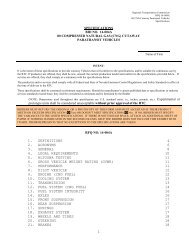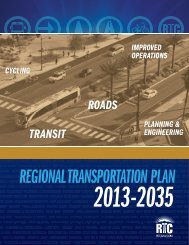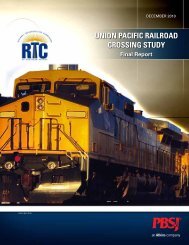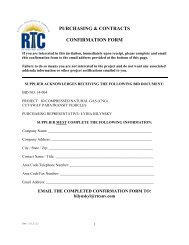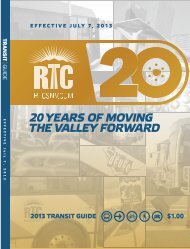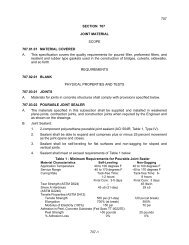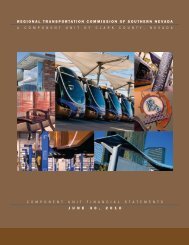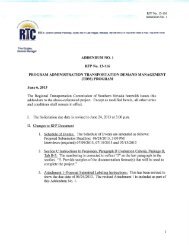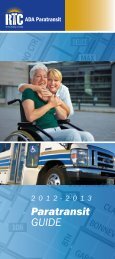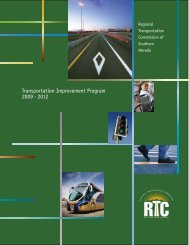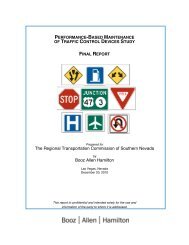(Blue Diamond Road) Corridor Study - Regional Transportation ...
(Blue Diamond Road) Corridor Study - Regional Transportation ...
(Blue Diamond Road) Corridor Study - Regional Transportation ...
You also want an ePaper? Increase the reach of your titles
YUMPU automatically turns print PDFs into web optimized ePapers that Google loves.
2. Current Conditions of <strong>Study</strong> Area RTC SR-160 <strong>Corridor</strong> <strong>Study</strong><br />
160 experiences recurring peak hour traffic congestion, with the highest percentage of<br />
failing service occurring between I-15 and Valley View Blvd. Exhibit 2-12 summarizes the<br />
level of service (LOS) at five locations along the eastern segment of SR-160 between Valley<br />
View Blvd and Las Vegas Boulevard South. The analysis shows LOS for 2003 and<br />
projections LOS for 2023, based on 20-year traffic projections.<br />
Similar to state roads in most urban areas, SR-160 suffers from traffic congestion as it fills<br />
up with commuters traveling to and from work in the morning and afternoon rush hours. In<br />
addition, a high volume of heavy duty trucks carrying building materials to construction<br />
sites east of Valley View contributes to traffic problems. Additionally, SR-160 has become<br />
an increasingly popular travel shed for a growing share of commute trips originating from<br />
Pahrump into the heart of Las Vegas. The I-15 interchange and Las Vegas Boulevard during<br />
the peak period were at LOS D, indicating a high density of traffic and intermittent<br />
breakdowns. As mentioned previously, most of the breakdowns occur between Dean Martin<br />
Drive and Valley View Blvd, where insufficient storage capacity on the intersection<br />
approaches leads to excessive queuing. In the “no build” alternative, these intersections<br />
are projected to operate at or below LOS F or ‘traffic gridlock’ in 2023.<br />
The “build” scenario involves reconstruction of the SR-160/I-15 interchange with capacity<br />
improvements on the approaches, consistent with the Phase 2A and 2B construction designs<br />
shown in Exhibit A. Under the 2030 Build scenario, the capacity improvements planned by<br />
NDOT are projected to result in LOS ranging between C and D. With the Flyover alternative,<br />
LOS on the southbound ramp of SR-160 improves from a D to a C.<br />
EXHIBIT 2-12: Level of Service (LOS) along SR-160<br />
2003 NB 2023 NB* 2003 Build 2023 Build* 2023 Build**<br />
Las Vegas Blvd D 1 F D C C<br />
NB Ramp Terminal D 2 F C C C<br />
SB Ramp Terminal D 3 F C D C<br />
Industrial <strong>Road</strong> C 4 F C D D<br />
Valley View B 5 F B D D<br />
LOS E or worse for the following locations:<br />
* analyzed without flyer<br />
1. NB left, NB thru, SB left, EB left, WB left ** analyzed with flyover<br />
2. NB left, WB thru<br />
3. EB thru, WB left, WB thru<br />
4. NB thru, SB left, EB left, WB left<br />
5. SB left, EB left<br />
Source: Nevada Department of <strong>Transportation</strong> (NDOT)<br />
Traffic Operations Analysis Division<br />
2-21



